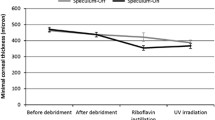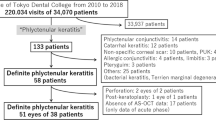Abstract
Purpose
Excimer laser phototherapeutic keratectomy (PTK) is a safe treatment for superficial corneal opacities, e.g., in corneal dystrophies or degenerations. Nevertheless, no standardized treatment protocols are available and intraoperative monitoring was not possible, so far. Here we evaluate the potential benefits of the intraoperative assessment by microscope-integrated intraoperative optical coherence tomography (MI-OCT) of corneal optical properties during PTK.
Methods
Retrospective study of eight patients (one male, seven females; age range, 43–80 years, mean = 66.1 years) using an 840-nm microscope-integrated spectral-domain OCT (iOCT; OptoMedical Technologies, Luebeck, Germany adapted to HS Hi-R Neo 900A, Haag Streit Surgical, Wedel, Germany). Images were acquired before and after corneal abrasion and after PTK. For PTK, a SCHWIND Amaris 750S excimer laser (SCHWIND eye-tech-solutions GmbH und KO. KG) was used. Parameters assessed were the central corneal thickness (CCT), changes in central depth-dependent corneal tissue intensity (TI), and corneal surface roughness (SR) in cross-sectional images of the cornea.
Results
Intraoperative monitoring using microscope-integrated OCT was possible in all patients at all time points. TI of the anterior corneal stroma decreased significantly (p = 0.037) after PTK (T1 = 15.1 ± 3.6, T2 = 15.0 ± 3.84, T3 = 13.7 ± 3.38), but not after corneal abrasion alone, indicating increased transparency caused by excimer laser PTK. CCT was significantly lower after corneal abrasion (p = 0.017), but not after PTK (T1 = 630.4 ± 70 μm, T2 = 544.1 ± 59.4 μm, T3 = 558.3 ± 52.5 μm. SR significantly decreased (p = 0.043) after PTK (T1 = 614.4 ± 37.5 pixels, T2 = 634.4 ± 35.6 pixels, T3 = 611.0 ± 40.3 pixels).
Conclusions
Intraoperative OCT allows real-time imaging during PTK and the assessment of corneal optical transparency and its surface roughness. It has to be clarified in larger studies if these parameters correlate with later postoperative visual outcomes.




Similar content being viewed by others
References
Campos M, Nielsen S, Szerenyi K, Garbus JJ, McDonnell PJ (1993) Clinical follow-up of phototherapeutic keratectomy for treatment of corneal opacities. Am J Ophthalmol 115:433–440
Dinh R, Rapuano CJ, Cohen EJ, Laibson PR (1999) Recurrence of corneal dystrophy after excimer laser phototherapeutic keratectomy. Ophthalmology 106:1490–1497
Fagerholm P, Fitzsimmons TD, Örndahl M, Öhman L, Tengroth B (1993) Phototherapeutic keratectomy: long-term results in 166 eyes. J Refract Surg 9:S76–S81
Mehlan J, Steinberg J, Traber L, Katz T, Linke S (2016) Recurrence rate and subjective symptoms after standardized (Hamburg protocol) phototherapeutic keratectomy on recurrent corneal erosions. Graefes Arch Clin Exp Ophthalmol 254(10):2005–2009
Reddy JC, Rapuano CJ, Felipe AF, Nagra PK, Hammersmith KM (2014) Quality of vision after excimer laser phototherapeutic keratectomy with intraoperative mitomycin-C for Salzmann nodular degeneration. Eye Contact Lens 40:213–219
Ma JJ, Tseng SS, Yarascavitch BA (2009) Anterior segment optical coherence tomography for transepithelial phototherapeutic keratectomy in central corneal stromal scarring. Cornea 28:927–929
Mori H, Miura M, Iwasaki T, Goto H, Sakurai Y, Watanabe Y, Yasuno Y (2009) Three-dimensional optical coherence tomography-guided phototherapeutic keratectomy for granular corneal dystrophy. Cornea 28:944–947
Wirbelauer C, Scholz C, Häberle H, Laqua H, Pham DT (2002) Corneal optical coherence tomography before and after phototherapeutic keratectomy for recurrent epithelial erosions. J Cataract Refract Surg 28:1629–1635
Wirbelauer C, Scholz C, Hoerauf H, Engelhardt R, Birngruber R, Laqua H (2000) Corneal optical coherence tomography before and immediately after excimer laser photorefractive keratectomy. Am J Ophthalmol 130:693–699
Siebelmann S, Steven P, Cursiefen C (2015) Intraoperative optical coherence tomography: ocular surgery on a higher level or just nice pictures? JAMA Ophthalmol 133:1133–1134
Steven P, Le Blanc C, Lankenau E, Krug M, Oelckers S, Heindl LM, Gehlsen U, Huettmann G, Cursiefen C (2014) Optimising deep anterior lamellar keratoplasty (DALK) using intraoperative online optical coherence tomography (iOCT). Br J Ophthalmol. https://doi.org/10.1136/bjophthalmol-2013-304585
Steven P, Le Blanc C, Velten K, Lankenau E, Krug M, Oelckers S, Heindl LM, Gehlsen U, Hüttmann G, Cursiefen C (2013) Optimizing Descemet membrane endothelial keratoplasty using intraoperative optical coherence tomography. JAMA Ophthalmol 131:1135–1142
Siebelmann S, Steven P, Hos D, Lankenau E, Bachmann B, Cursiefen C (2016) Advantages of microscope-integrated intraoperative online optical coherence tomography: usage in Boston keratoprosthesis type I surgery. J Biomed Opt 21:016005–016005
Siebelmann S, Cursiefen C, Lappas A, Dietlein T (2016) Intraoperative optical coherence tomography enables noncontact imaging during Canaloplasty. J Glaucoma. https://doi.org/10.1097/IJG.0000000000000367
Siebelmann S, Bachmann B, Lappas A, Dietlein TS, Steven P, Cursiefen C (2016) Intraoperative Optische Kohärenztomographie bei Narkoseuntersuchungen von Säuglingen und Kleinkindern. Ophthalmologe 113(8):651–655
Siebelmann S, Hermann M, Dietlein T, Bachmann B, Steven P, Cursiefen C (2015) Intraoperative optical coherence tomography in children with anterior segment anomalies. Ophthalmology. https://doi.org/10.1016/j.ophtha.2015.06.004
Ehlers JP, Kaiser PK, Srivastava SK (2014) Intraoperative optical coherence tomography using the RESCAN 700: preliminary results from the DISCOVER study. Br J Ophthalmol. https://doi.org/10.1136/bjophthalmol-2014-305294
Ehlers JP, Dupps WJ, Kaiser PK, Goshe J, Singh RP, Petkovsek D, Srivastava SK (2014) The prospective Intraoperative and Perioperative ophthalmic ImagiNg with optical CoherEncE TomogRaphy (PIONEER) study: 2-year results. Am J Ophthalmol 158:999–1007 e1001
McCafferty SJ, Schwiegerling JT, Enikov ET (2012) Corneal surface asphericity, roughness, and transverse contraction after uniform scanning excimer laser ablation. Invest Ophthalmol Vis Sci 53:1296–1305
Kornmehl EW, Steinert RF, Puliafito CA (1991) A comparative study of masking fluids for excimer laser phototherapeutic keratectomy. Arch Ophthalmol 109:860–863
Raiskup-Wolf F, Hoyer A, Spoerl E, Pillunat LE (2008) Collagen crosslinking with riboflavin and ultraviolet-a light in keratoconus: long-term results. J Cataract Refract Surg 34:796–801
Schmidinger G, Pachala M (2012) Corneal pachymetry changes induced by different riboflavin solutions measured by optical coherence tomography. Invest Ophthalmol Vis Sci 53:4054–4054
Acknowledgements
We thank Mrs. J. Austin for native language check.
Funding
DFG FOR 2240 “(Lymph)Angiogenesis and Cellular Immunity in Inflammatory Diseases of the Eye” (SS, JH, CC; www.for2240.de); EU COST BM 1302 (BB, CC, SS; www.biocornea.eu) and EU ARREST BLINDNESS (CC, www.arrestblindness.eu). The sponsor or funding organization had no role in the design or conduct of this research. SS received a travel grant from Haag Streit Surgical.
The sponsors provided financial support in the form of personnel funding. All sponsors had no role in the design or conduct of this research.
Author information
Authors and Affiliations
Contributions
Study concept, design: Siebelmann, Cursiefen.
Data collection/measurements: Siebelmann, Scholz, Hermann.
Analysis and interpretation of data: Siebelmann, Scholz, Matthaei, Bachmann, Horstmann, Cursiefen.
Drafting of the manuscript: Siebelmann, Scholz, Cursiefen.
Critical revision of the manuscript for intellectual content: Siebelmann, Scholz, Horstmann, Bachmann, Cursiefen.
Administrative, technical or material support: Siebelmann, Horstmann, Cursiefen.
Sebastian Siebelmann and Claus Cursiefen had full access to all of the data in the study and take responsibility for the integrity of the data and the accuracy of the data analysis.
Corresponding author
Ethics declarations
Conflict of interest
All authors certify that they have no affiliations with or involvement in any organization or entity with any financial interest (such as honoraria; educational grants; participation in speakers’ bureaus; membership, employment, consultancies, stock ownership, or other equity interest; and expert testimony or patent-licensing arrangements), or non-financial interest (such as personal or professional relationships, affiliations, knowledge or beliefs) in the subject matter or materials discussed in this manuscript.
Ethical approval
All procedures performed in studies involving human participants were in accordance with the ethical standards of the institutional and/or national research committee (Ethics committee of the University Hospital of Cologne, File number 1 and with the 1964 Helsinki Declaration and its later amendments or comparable ethical standards.
Financial disclosures
None.
Rights and permissions
About this article
Cite this article
Siebelmann, S., Horstmann, J., Scholz, P. et al. Intraoperative changes in corneal structure during excimer laser phototherapeutic keratectomy (PTK) assessed by intraoperative optical coherence tomography. Graefes Arch Clin Exp Ophthalmol 256, 575–581 (2018). https://doi.org/10.1007/s00417-017-3867-7
Received:
Revised:
Accepted:
Published:
Issue Date:
DOI: https://doi.org/10.1007/s00417-017-3867-7




